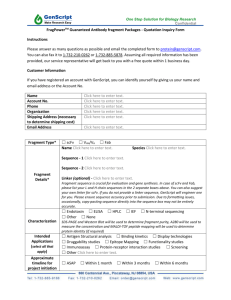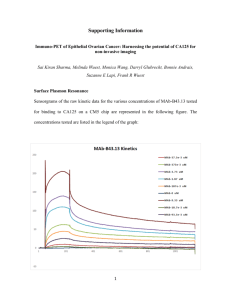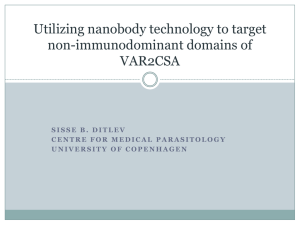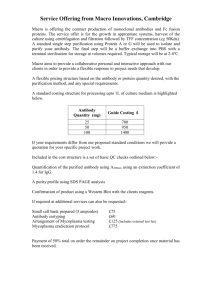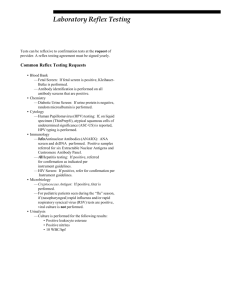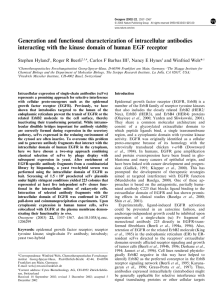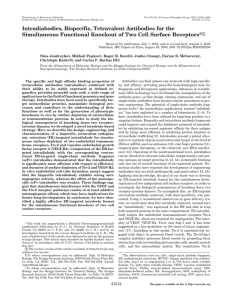4. Notes - HAL
advertisement
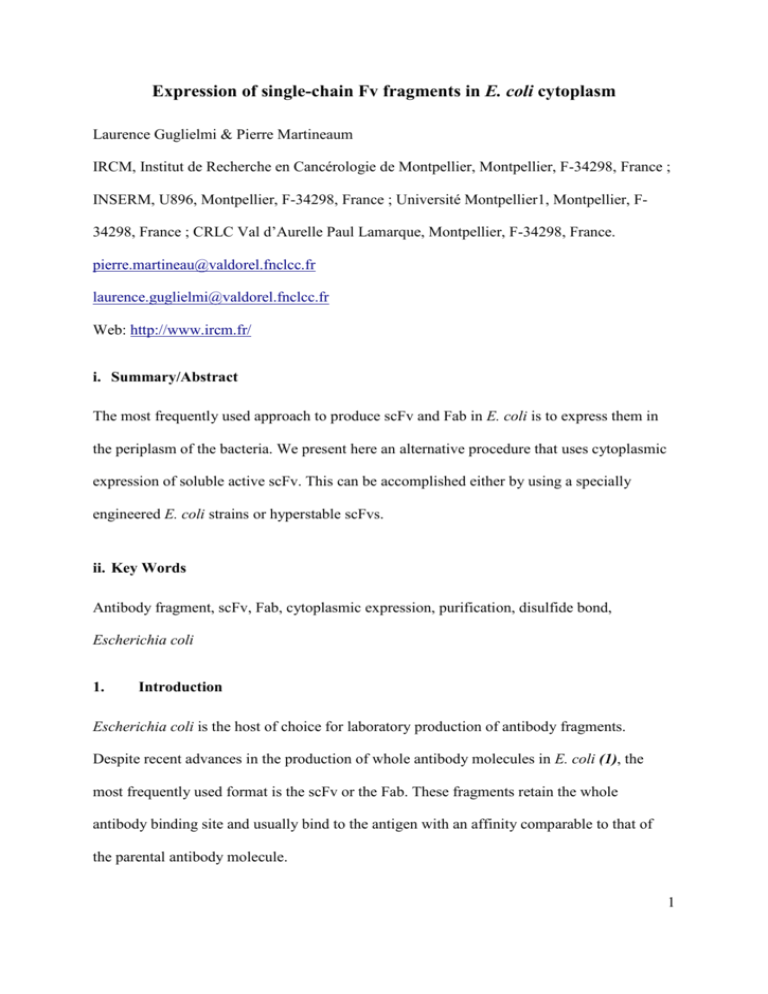
Expression of single-chain Fv fragments in E. coli cytoplasm Laurence Guglielmi & Pierre Martineaum IRCM, Institut de Recherche en Cancérologie de Montpellier, Montpellier, F-34298, France ; INSERM, U896, Montpellier, F-34298, France ; Université Montpellier1, Montpellier, F34298, France ; CRLC Val d’Aurelle Paul Lamarque, Montpellier, F-34298, France. pierre.martineau@valdorel.fnclcc.fr laurence.guglielmi@valdorel.fnclcc.fr Web: http://www.ircm.fr/ i. Summary/Abstract The most frequently used approach to produce scFv and Fab in E. coli is to express them in the periplasm of the bacteria. We present here an alternative procedure that uses cytoplasmic expression of soluble active scFv. This can be accomplished either by using a specially engineered E. coli strains or hyperstable scFvs. ii. Key Words Antibody fragment, scFv, Fab, cytoplasmic expression, purification, disulfide bond, Escherichia coli 1. Introduction Escherichia coli is the host of choice for laboratory production of antibody fragments. Despite recent advances in the production of whole antibody molecules in E. coli (1), the most frequently used format is the scFv or the Fab. These fragments retain the whole antibody binding site and usually bind to the antigen with an affinity comparable to that of the parental antibody molecule. 1 When expressed in B cells, antibodies are secreted molecules containing glycosylations and disulfide bonds. Glycosylations are required for the effector functions and are mainly located in the Fc fragment. Since this part of the antibody is not present in both scFv and Fab molecules, the absence of glycosylation modifications in E. coli is not an obstacle to their production in this host. There are two kinds of disulfide bonds in antibody molecules, interand intra-domain. Inter-domain disulfide bonds link together the heavy and light chains and are present in Fab but not in scFv, and intra-domain disulfide bonds are a hallmark of the so called “immunoglobulin fold” and are present in two copies in scFv and four copies in Fab. The intra-domain disulfide bond is crucial for the stability of the antibody molecule. Indeed, reduction of the two disulfide bonds of a scFv results in a decrease of about 5 kcal/mol which is close to the intrinsic stability of many antibody domains (2). This explains why the first successful expression of active antibody fragments in E. coli has been obtained in the periplasm of the bacteria where disulfide formation is promoted by the dsb machinery (3). This is still the most frequently used approach to produce scFv and Fab in E. coli (4). An alternative approach to produce antibody fragments in E. coli is to express them in the cytoplasm. It has been known for years that much higher expression levels can be obtained in this compartment, albeit usually as aggregated and/or inactive molecules. The main explanation is presumably the absence of disulfide bond formation in the reducing environment of the cytoplasm, resulting in unstable antibody fragments, either aggregated or quickly degraded by the cell. There are however other factors that may influence the production of antibody fragments in the cytoplasm like the kinetic competition between folding, aggregation and degradation (5,6). In the recent years, two approaches have been developed to improve the production of active antibody fragments in E. coli cytoplasm: the use of E. coli mutant strains that promote disulfide bond formation in the cytoplasm, and the selection and engineering of hyperstable 2 antibody fragments. Of course both approaches can be combined by expressing hyperstable antibody fragments in such mutant E. coli strains. In E. coli, the reducing environment of the cytoplasmic compartment is maintained by the thioredoxin and the glutathione pathways. Using elegant genetic selections, Jon Beckwith and collaborators (3) selected a triple mutant strain containing knockouts in the two pathways (trxB and gor) but with a compensatory point mutation in the ahpC gene that allowed an almost normal growth of the bacteria. This E. coli strain allows the expression of scFv and Fab fragments at levels comparable to that obtained in the periplasm. We will describe a step-by-step procedure to test the expression of your antibody fragment in E. coli cytoplasm, then to purify it. We usually use scFv but the approach could also be used for Fab fragments. It is worth noting that this approach will be particularly successful if the intrinsic stability of your scFv is in the upper range of the values obtained for scFv molecules. This should be the case if your scFv has been selected from optimized libraries (710) or if the VH is from human families 1,3 or 5 (11). 2. Materials 1. scFv cloned in a pET derived vector (see Note 1). 2. BL21(DE3), BL21(DE3)pLys, Origami (DE3), Origami (DE3)pLysS (see Note 2). 3. LBG plates: 10 g tryptone (peptone), 5 g yeast extract, 10 g NaCl, make up to 1 liter with water, adjust pH to 7.0 with 5 N NaOH, add 15 g of agar and autoclave. Allow the solution to cool to 60 °C or less, add 50 ml of 40% glucose solution (autoclaved), suitable antibiotics (100 μg/ml ampicillin and eventually 25 μg/ml of chloramphenicol), then pour the plates. 4. Ampicillin: Dissolve 1 g of ampicillin (sodium salt) in 10 ml of ultrapure water. 3 Filter-sterilize (0.22 μm) and store in 1 ml aliquots at -20 °C (see Note 3). 5. Chloramphenicol: 25 mg/ml in 95% ethanol. Store at -20 °C. 6. 17 mm x 100 mm 14 ml sterile culture tubes (e.g. VWR #211-0085). 7. ZY: 10 g N-Z-amine AS (or any tryptic digest of casein, e.g. tryptone/peptone), 5 g yeast extract, 925 ml water. Autoclave. 8. 20xNPS: H2O 900 ml, (NH4)2SO4 66 g, KH2PO4 136 g, Na2HPO4 142 g. Add in sequence in a beaker, stir until all dissolved. The pH of a 20-fold dilution in water should be about 6.75. Autoclave. 1xNPS: 100 mM PO43-, 25 mM SO42-, 50 mM NH4+, 100 mM Na+, 50 mM K+. 9. 50x5052. To make 1 liter: 250 g glycerol (weigh in beaker), 730 ml water, 25 g glucose, 100 g α-lactose. Add in sequence in beaker, stir until all dissolved. Autoclave. 1x5052: 0.5 % glycerol, 0.05% glucose, 0.2% α-lactose (see Note 4). 10. 1 M MgSO4: 24.65 g MgSO4.7H2O in 100 ml of water. Autoclave. 11. ZYP-5052: ZY 0.93 liter, 1 M MgSO4 1 ml, 50x5052 20 ml, 20xNPS 50 ml. Prepare the day of use using the stock solutions (see Note 5). 12. TE: Tris 50 mM, EDTA 1 mM pH 8. Store at 4 °C. 13. 10 mg/ml Lysozyme solution in TE (see Note 6). 14. Benzonase (see Note 7). 15. 5 M NaCl. 16. 10% Nonidet P-40 (w/v). Store at RT. 17. 1 M Imidazol in water (see Note 8). 18. Nickel Affinity Gel (see Note 9). 4 19. 5xPBN: 29.82 g Na2HPO4, 5.52 g NaH2PO4.H2O, 147 g NaCl, make up to 1 liter with H2O, autoclave. Store at RT. 1xPBN: 50 mM PO43-, 0.5 M NaCl, pH 7.5. 20. WB. For 20 ml: 4 ml 5xPBN, 0.4 ml 1 M Imidazol, 15.6 ml H2O. 21. EB. For 15 ml: 3 ml 5xPBN, 4.5 ml 1 M Imidazol, 7.5 ml H2O. 22. PBSx10: 6.1 g Na2HPO4, 2 g KH2PO4, NaCl 80 g, 2 g KCl, make up to 1 liter with H2O, autoclave. 23. 8 M Guanidine Hydrochloride solution (see Note 10). 24. DB. For 1 ml: 100 μl PBSx10, 500 μl 8 M GndHCl, 400 μl H2O. 25. 100 mM DTT: 15.4 mg/ml in H2O, make fresh the day of use. 26. One desalting Spin Column for 100 μl volume sample. We use Pierce Zeba Spin 0.5 ml Desalting Columns #89882. 27. DTNBx2. 0.8 mg/ml of 5,5'-Dithio-bis(2-nitrobenzoic acid) in DB (see Note 11). 3. Methods 3.1. Small scale expression 1. Clone your scFv in pET23d(+) vector (see Note 1). Transform BL21(DE3), BL21(DE3)pLysS, Origami(DE3), Origami(DE3)pLysS with the plasmid (see Note 2 & 12). 2. Late in the morning, pick 1 colony of each transformation in a 17 mm x 100 mm sterile culture tube containing 1 ml of ZYP-5052 and the suitable antibiotics (see Note 12). 3. Grow with vigorous agitation at 37 °C until the OD600nm reaches .4 (see Note 13). 5 4. Grow overnight at 24 °C with vigorous agitation (see Note 14). 5. Transfer in 1.5 ml microtubes and centrifuge for 5 min at 5,000 g at 4 °C. Remove the supernatant by aspiration and proceed with “Small scale cell lysis” (see Note 15). 3.2. Small scale cell lysis All the steps must be done at 4 °C, either on ice or in a cold-room. 1. Freeze/Thaw the pellet twice in a dry ice/ethanol bath (see Note 16). 2. Resuspend carefully the pellet in 100 μl of cold TE by pipetting up and down or/and by vortexing. 3. Add 10 μl of a 3 mg/ml solution of Lysozyme (see Note 6 & 17). 4. Incubate for 1 h on ice. 5. Add 7 μl of 5 M NaCl. Mix gently. 6. Add 7.5 μl of 10% Nonidet P-40. Mix gently. 7. Add 10U/ml Benzonase (i.e., 1 U) and incubate 10-15 min RT (see Note 7 & 18). 8. Centrifuge for 15 min at 13,000 g at 4 °C. 9. Transfer the supernatant in a clean tube (see Note 19). 10. Analyze the soluble fractions to determine the best expression system (see Note 20). 3.3. Large-scale purification All the steps must be done at 4 °C, either on ice or in a cold-room. 1. Early in the morning, pick 1 colony in a 17 mm x 100 mm sterile culture tube containing 2 ml of ZYP-5052 and the suitable antibiotics and grow at 37 °C with vigorous shaking until OD600nm reaches 0.5 (see Note 12 & 13). 6 2. Poor the tube in a 200 ml flask containing 40 ml of ZYP-5052 and the suitable antibiotics and grow at 37 °C with vigorous shaking until OD600nm reaches 0.5 (see Note 12 & 13). 3. Poor the flask in a 5 liter flask containing 1 liter of ZYP-5052 and the suitable antibiotics and grow over-night at 24 °C with vigorous shaking (see Note 12--14 & 21). 4. Cool down the culture on ice for 15 min, centrifuge at 3,000 g for 15 min at 4 °C then discard the supernatant (see Note 15). 5. Freeze in a dry ice/ethanol bath then thaw in a water bath at RT. For better results, repeat this Freezing/Thawing step (see Note 16). 6. Resuspend the pellet in 20 ml of cold TE. 7. Add 600 μl of a 10 mg/ml lysozyme solution in TE and incubate for 1 h on ice (see Note 17). 8. Add 1.4 ml of 5 M NaCl and mix gently by inverting the tube about 5 times (see Note 22). 9. Add 1.5 ml of 10% Nonidet P-40 and mix gently by inverting the tube about 5 times. 10. Add 115 μl of 1 M MgSO4 and 50 U/ml of Benzonase (1000 U) and incubate 10-15 min RT (see Note 18). 11. Centrifuge for 30 min at 16,000 g at 4 °C. 12. Filter using a 0.45 μm filter mounted on a 20 ml syringe (see Note 23). 13. Add 460 μl of a 1 M imidazol solution. 14. Apply on a 2 ml equilibrated “Metal Chelate Affinity” column (see Note 9). 15. Wash with 10 ml of WB. 7 16. Elute with 10 ml of EB and collect 1 ml fractions. 17. Measure the absorbance at 280nm of the fractions using EB as blank (see Note 24) and pool the best fractions. 18. Desalt against PBS either by dialysis or gel exclusion chromatography. 19. Measure the protein concentration and store in aliquots at -20 °C or -80 °C (see Note 25 & 26). 3.4. Estimation of disulfide bonds (see Note 27) 1. Dissolve ~ 50 μg of purified scFv in 150 μl of DB: 50 μg scFv, 75 μl of 8 M GndHCl, 15 μl of PBSx10, H2O to 150 μl. This will be called Sox below. 2. Transfer in a new tube 75 μl of this mix and add 0.75 μl of 100 mM DTT (see Note 28). 3. Incubate both tubes 1 h at RT (see Note 29). 4. Equilibrate a Spin column in DB and apply the 75 μl from step 2 on it (see Note 30). Recover the 75 μl in a new tube. This will be called Sred below. 5. Add 60 μl of DTNBx2 to 60 μl of Sox and Sred and incubate at RT for ~ 5 min. 6. Measure the absorbance of both samples at 412 nm against DTNBx1 (75 μl DTNBx2 + 75 μl of DB) in a 100 μl cuvette (see Note 31). 7. Calculate the percentage of oxidized scFv in your purified protein preparation using the formula: 100% - 100 * A412nm[Sox]/A412nm[Sred]. Most preparation should give a value between 50 and 100 %. 4. Notes 1. scFv isolated from phage libraries can usually be cloned as NcoI-NotI fragment in 8 vector pET23d(+) from Novagen. The resulting scFv will be tagged at its C-terminal extremity with a 6 Histidine tag that will be used for the purification in protocol 3.3. A modified vector that adds an extra c-myc tag for easy detection using the 9E10 antibody is available on request (pET23NN: (6)). 2. The four strains are available from Novagen. If you do not want to test the four strains, use BL21(DE3) and Origami(DE3) only. The protocol described here uses an auto-inducible medium developed by Dr. Studier (12) and requires a lac+ strain. It is thus not possible to use Origami2 strains with this protocol since they are lac-. 3. Anhydrous ampicillin must be dissolved in 0.3 M NaOH. 4. Lactose is slow to dissolve. Heating the solution in a microwave oven may help. 5. Mix in the indicated order to avoid precipitation. 6. Make a fresh solution the day of use. We use chicken egg Lysozyme from Fluka (>100,000 u/mg, #62970). Alternatively, you can use Lysozymes from phages like rLysozyme from Novagen or Ready-Lyse form Epicentre Biotechnologies. 7. Benzonase is a nuclease that digests both DNA and RNA and is available from Merck and Sigma. You can substitute it with DNAseI by adding it at a 10 μg/ml final concentration in presence of 5 mM Mg2+. 8. Many Imidazol batches contain impurities that absorb at 280 nm. Buy a grade tested for low UV absorbance, e.g. Merck #1.04716 or Sigma BioUltra #56748. 9. We use HIS-Select® Nickel Affinity Gel from Sigma (#P6611). The capacity is about 20 mg/ml of packed gel. We pack the desired volume in a Biorad Econo-Pac Chromatography Columns (#732-1010). Resin from other suppliers should give equivalent results. If the column color turns from blue to white after applying the sample, remove the EDTA by dialysis against PBS, re-generate the column (see Note 9 26) then re-apply the dialyzed sample. 10. Because GndHCl is highly hygroscopic, it is not possible to prepare the solution by weighting. Either buy it directly in solution (e.g. Pierce #24115) or use a refractometer to measure the precise concentration (13). 11. The solution should be of a light green-yellow color. You can store it at 4 °C and use it until the color turns deeper. 12. For BL21(DE3) and Origami(DE3) use LBG/ampicillin plates. If the strain contains the pLys plasmid, use LBG/ampicillin/chloramphenicol plates. To make a glycerol stock of your strain, grow a clone in 1 ml of LBG/ampicillin (and chloramphenicol for pLys strains) until OD600nm reaches 0.8, add 8-10 % (w/v) sterile glycerol, then freeze at -70 °C. You can directly start a culture from this glycerol stock by scraping the surface with a sterile toothpick or a micropipette tip. 13. To get efficient induction it is very important to well oxygenate the culture. In our shaker (Infors Multitron 2) we use 240 rpm, but this may be adjusted for your shaker model. For large cultures, baffled flasks are very efficient but normal flasks usually work well. 14. To maintain the temperature at 24 °C a refrigerated shaker is required. If it is not available, you can shake your flask at RT or at the lowest possible temperature that you can maintain in your shaker (usually about 27 °C). 15. You can stop at this step and freeze the pellets at -20 °C for later processing. 16. If dry ice is not available, you can freeze the pellet once at -20 °C. Thaw the pellet in a RT water bath for 5 min. 17. You can omit this step if your strain contains the pLys plasmid since the T7 lysozyme expressed from this plasmid will be sufficient for an efficient lysis. 10 18. It is also possible to keep the tube on ice but longer incubation time will be necessary. Alternatively, for large scale purifications, draw the lysate through a narrow-gauge syringe needle several times to reduce viscosity. 19. You can save the pellet for analysis of the insoluble fraction. 20. The analysis method used will depend on your scFv. The best is to use a method which is dependent on the activity of your scFv, e.g. ELISA. If your scFv is only tagged with the 6 His tag, you can use an anti-His monoclonal antibody (e.g. Sigma #A7058). If such a method is not available, just compare the soluble expression levels by Coomassie stained SDS-PAGE gel and Western blot. If possible, include as control the same scFv produced in the periplasm of E. coli (4). If the results are comparable we usually prefer BL21(DE3), with or without pLys, since it is deficient in lon and ompT proteases and grows better than the trxB gor ahpC mutant strains. 21. The final DO600nm should be about 5. 22. Lysis of saturated cultures of E. coli is difficult. The protocol given here allows efficient lysis without any special equipment. If you have access to a French press, you can use it and omit steps 8-9. If you have a sonicator, you can replace step 10 (but still add the MgSO4 for the later purification steps) by a 1 min sonication at a moderate power on ice using short pulses: this will shear the DNA and allow a more complete lysis. 23. If the extract is still not clear after step 11, centrifuge a second time at 20,000 g for 30 min before the filtration. You can change the filter 2-3 times during filtration if the pressure is too high. 24. Alternatively you can use other protein determination method, e.g. Bradford Protein Assay. 11 25. A 1 mg/ml scFv solution has an absorbance of about 1.5 (see Note 24). Store aliquots at -20 or -80 °C, avoid freeze/thaw. It is better to store purified scFv at a concentration of at least 1 mg/ml. If it is not the case, you can concentrate your protein or add 10 mg/ml of purified BSA before freezing. 26. We use the same column at least 10 times using the following regeneration protocol: Wash successively with 5 ml H2O, 10 ml 6 M Guanidine Hydrochloride, 5 ml H2O, 10 ml 100 mM EDTA, 5 ml H2O, 5 ml 10 mg/ml NiSO4, 5 ml H2O. Equilibrate the column with 10 ml of EB for immediate use or 30% ethanol for storage at 4 °C. 27. Most of the scFv is expressed as reduced protein in the cell cytoplasm, even in trxB gor ahpC mutant strains. However, the protein will oxidize during extraction if the protein is correctly folded and the fraction of oxidized cysteine residues, as measured in this protocol, is thus a good indicator of native protein. It is however not always the case as, for instance, in the case of the scFvs based on the scFv13R4 framework that contain only one disulfide bond when purified from the cytoplasm (10). Of course a precise determination of the active fraction using a functional test like ELISA or Surface Plasmon Resonance could be performed and would be more relevant. 28. Most protocols use 10-100 mM DTT. However, 1 mM is already a 100-fold molar excess over scFv and is easier to remove completely in step 4. 29. You can increase this incubation step up to ON at RT. 30. You can replace the spin column by a gravity column or dialysis for a few hours with two changes of a few hundred ml of DB. The advantage of the spin column is that it does not dilute the sample. If you change the dialysis conditions or use another brand of spin column you must check that DTT is fully removed by performing the experiment without protein and verifying that the A412nm obtained at step 6 is close to 12 zero. If you use dialysis or a gravity column, record the sample volume after desalting and add the dilution factor in the formula given in step 7. 31. If you don't have 100 μl cuvette, you can order disposable 100 μl plastic cuvettes, e.g. BRAND UV-Cuvette. You don't need UV-transparent cuvettes but it seems that small cuvettes only exist in quartz and UV-transparent plastic. References 1. Mazor, Y., Van Blarcom, T., Mabry, R., Iverson, B. L. and Georgiou, G. (2007) Isolation of engineered, full-length antibodies from libraries expressed in Escherichia coli. Nat. Biotechnol. 25, 563-565. 2. Worn, A. and Pluckthun, A. (1998) An intrinsically stable antibody scFv fragment can tolerate the loss of both disulfide bonds and fold correctly. FEBS Lett. 427, 357-361. 3. Ritz, D. and Beckwith, J. (2001) Roles of thiol-redox pathways in bacteria. Annu. Rev. Microbiol. 55, 21-48. 4. Kipriyanov, S. M. (2002) High-level periplasmic expression and purification of scFvs. Methods Mol. Biol. 178, 333-341. 5. Martineau, P. and Betton, J. M. (1999) In vitro folding and thermodynamic stability of an antibody fragment selected in vivo for high expression levels in Escherichia coli cytoplasm. J. Mol. Biol. 292, 921-929. 6. Philibert, P. and Martineau, P. (2004) Directed evolution of single-chain Fv for cytoplasmic expression using the beta-galactosidase complementation assay results in proteins highly susceptible to protease degradation and aggregation. Microb. Cell Fact. 3, 16. 13 7. Auf der Maur, A., Zahnd, C., Fischer, F., Spinelli, S., Honegger, A., Cambillau, C., Escher, D., Pluckthun, A. and Barberis, A. (2002) Direct in vivo screening of intrabody libraries constructed on a highly stable single-chain framework. J. Biol. Chem. 277, 45075-45085. 8. Tanaka, T., Chung, G. T. Y., Forster, A., Lobato, M. N. and Rabbitts, T. H. (2003) De novo production of diverse intracellular antibody libraries.. Nucleic Acids Res. 31, e23. 9. Villani, M. E., Di Carli, M., Donini, M., Traversini, G., Lico, C., Franconi, R., Benvenuto, E. and Desiderio, A. (2008) Validation of a stable recombinant antibodies repertoire for the direct selection of functional intracellular reagents. J. Immunol. Methods 329, 11-20. 10. Philibert, P., Stoessel, A., Wang, W., Sibler, A., Bec, N., Larroque, C., Saven, J. G., Courtete, J., Weiss, E. and Martineau, P. (2007) A focused antibody library for selecting scFvs expressed at high levels in the cytoplasm. BMC Biotechnol. 7, 81. 11. Ewert, S., Honegger, A. and Plückthun, A. (2004) Stability improvement of antibodies for extracellular and intracellular applications: CDR grafting to stable frameworks and structure-based framework engineering. Methods 34, 184-199. 12. Studier, F. W. (2005) Protein production by auto-induction in high density shaking cultures. Protein Expr. Purif. 41, 207-234. 13. Nozaki, Y. (1972) The preparation of guanidine hydrochloride. Meth. Enzymol. 26 PtC, 43-50. 14
